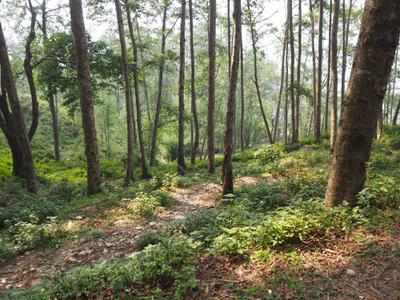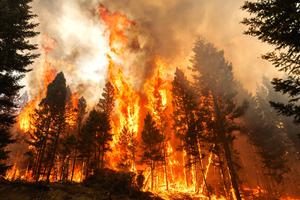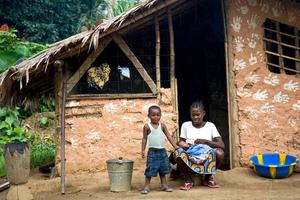One study showed that areas with the highest out-migration experienced the most forest recovery.
But there is another factor at play in Nepal’s forest resurgence: human migration. In recent decades, millions of Nepalis have left the country to work in the Persian Gulf, Southeast Asia, and beyond. As Nepalis wire money home, population and economic pressures shift away from agriculture to other types of rural and urban livelihoods. The families of migrants often rely less on forest products or they abandon farmland, aiding reforestation and helping create what one 2016 study termed a “remittance landscape,” referring to the funds sent back to Nepal. A 2018 study, which mapped the spatial distribution of reforestation and out-migration in Nepal, showed that the areas with the highest out-migration experienced, on average, the most forest recovery. There is a “strong positive effect of international out-migration on forest regeneration in Nepal,” the researchers concluded.
Globally, migration has important – though complex, and often ignored – impacts on forests. In many countries, forests appear to recover as people leave rural areas for work elsewhere. In El Salvador, for example, rural migration to cities and the United States has contributed to a forest rebound, as people have become less dependent on farming. In Guatemala and Nicaragua, on the other hand, foreign remittances have driven an expansion of cattle ranching that has harmed forests. Experts say that migration’s impacts on forests around the world – positive and negative – may play an important role in determining their fate.
From 1950 to 1980, Nepal lost much of its forest cover as a growing population cut trees to harvest timber and convert land to agriculture. By the 1970s, fears grew that deforestation was causing irreparable damage, including soil erosion, landslides, and downstream flooding. Part of the problem was centralized management: Nepal had nationalized all forests in the 1950s, but the government was often ill-equipped to oversee them. Bureaucrats were frequently unaware, or turned a blind eye, when villagers cut trees for household use. Sometimes, officials colluded with commercial loggers to illegally exploit timber.
An alder stand grows in former pastureland in the Daha Deurali community forest outside of Ghamir village. Peter Gill/Yale e360
In response, Nepal’s government tried what was then a novel solution: decentralize forest management by handing over responsibility to local communities. Unlike government officials, local people were seen as having a vested interest in preserving forest resources for long-term, sustainable use. They also were better positioned to monitor forests and enforce rules for harvesting forest products. In the late 1980s and early 1990s, the government began handing over roughly 4.5 million acres, or about 18 percent of the country’s forest area, to communities to manage. That led to a period of forest resurgence in most areas of the country, as highlighted by a number of academic studies, conservation organizations, and the media.
In Ghamir, the government gave the community a tract of degraded pasture and scrubland in 1998. Since then, the forest has regrown through a combination of natural regeneration and tree planting by locals, according to Bal Bahadur Karki, the elected chairman of the community forest management committee. Today, villagers are permitted to cut firewood for cooking and collect fodder for livestock; the expanding forest also has improved local water quality. “People became aware that we have to save the trees, because the community forest is important — it provides us so much,” says Karki.
However, community forestry is only part of Ghamir’s — and Nepal’s — forest-resurgence story.
On the outskirts of Ghamir sits a lone, stone cottage. Its owner, Dhan Bahadur Budda, is a wiry septuagenarian whose rigid posture betrays his military background. As a young man, he joined India’s Gurkha regiments — renowned fighting forces of Nepali origin — and fought the Chinese in the Sino-Indian War of 1962. Afterwards, Budda returned to a farming life in Ghamir, where he managed a homestead with his wife, five sons, and seven daughters. But his wife passed away some years ago, his daughters have all married into other households, and his sons are now working in construction, security, and as drivers in the United Arab Emirates and India.
Since 2008, Nepal has issued more than 3.5 million labor permits for workers to go abroad.
Because he has no one to help him, Budda no longer farms the terraced fields that surround his home, save for a small vegetable patch. Even growing vegetables is difficult, he says, because of monkeys that colonized the nearby community forest recently: “They love the radishes.” As Budda’s fields lie fallow, alders have begun growing on them.
Budda’s story mirrors a nationwide shift: While Nepalis have migrated to India for seasonal or military work for generations, international migration to other countries has surged in recent decades. Easier access to passports, coupled with a civil war from 1996 to 2006 and a dismal domestic economy, drove many Nepalis to seek opportunity abroad. Since 2008, the nation of 29 million has issued more than 3.5 million labor permits for workers to go abroad – mostly to the Middle East and Malaysia, although also to South Korea, Japan, Europe, and North America. More young Nepalis also have gone abroad to study. Most migrants are young men, though a growing number of women are also migrating. Nepal’s economy has become one of the most remittance-dependent in the world, with foreign transfers amounting to around a third of gross domestic product (GDP).
This international migration has eased pressure on the land and led to the reforestation of Nepal’s Himalayan foothills, says Bodh Raj Subedi, the divisional forest officer for Gulmi District: “You can see it across Gulmi. First the land turns to scrub, and then saplings start to grow. Eventually, it becomes a forest.”
With his children either living abroad or elsewhere, Dhan Bahadur Budda has stopped farming most of his land on the outskirts of Ghamir. Peter Gill/Yale e360
Several recent studies have found that the families of migrants reduce the area of land they cultivate, either because they do not have the manpower to farm or because remittances make them less dependent on agriculture. In other cases, migrants completely abandon their homes in the hills and settle elsewhere – either abroad or in Nepal’s urban areas, downstream valleys, or southern plains, where fertile soils and plentiful irrigation make farming easier.
In addition, remittance income has changed consumption patterns so that people depend less on forests for resources. Thirty years ago, nearly all rural Nepalis cooked on firewood, but today, many use canisters of liquified petroleum gas imported from India. Likewise, migrants’ families tend to build houses from brick and concrete instead of traditional stone-and-wood homes. Some have shifted from raising cattle and goats, which they fed fodder cut from the forest, to raising chickens on imported feed. Bright lights from factory-style chicken farms now dot the valley below Ghamir at night, like an inverted constellation telling the story of a great migration.
Johan Oldekop, an environmental social scientist at the University of Manchester in the United Kingdom who was the lead author of the 2018 remittance/reforestation study, says that both community forest management and migration have led to forest recovery, but that it is difficult to tease out their respective roles. One reason is that good data can be hard to come by. A scarcity of detailed maps of community forest boundaries makes it difficult to determine, using satellite images, exactly how much reforestation has taken place in community forests versus private land. Likewise, data on migration relies on the national census, which is nearly a decade old and provides only a snapshot in time.
Jefferson Fox, a geographer at the East-West Center at the University of Hawaii who leads the NASA-funded team researching Nepal’s forest resurgence, says his data indicate that both community forestry and migration are associated with forest recovery, but that community forestry is the more important factor. He and his colleagues also found that variables often associated with remittance income — such as families with brick and concrete houses, indoor plumbing, and motorcycle ownership — positively correlate with forest resurgence. Fox hopes that his team’s detailed analysis of Landsat images will provide a more comprehensive picture of Nepal’s reforestation.
Migration is “central to understanding the past, present, and future of forests and forest-based communities,” a report found.
History suggests that as populations transition from being dependent on agriculture to other sources of income, forests regrow. Geographers have posited this relationship in what they call “forest transition theory,” showing that in Europe and North America, industrialization in the 19th and 20th centuries contributed to widespread reforestation by pulling people off farms to new jobs in cities. Places that have undergone industrialization more recently — such as Puerto Rico — also have experienced reforestation.
In El Salvador, a civil war in the 1980s and subsequent migration to cities and the U.S. helped to reduce deforestation by causing a decline in agriculture and an expansion of agroforestry. As in Nepal, areas of El Salvador with more remittances correlated with greater forest recovery. In Mexico, case studies in Michoacan and Yucatan states show that remittance-dependent households abandon unproductive farmland, contributing to local reforestation, although as a whole Mexico experiences net deforestation.
In other cases, migration has had detrimental effects on forests. In Guatemala and Nicaragua, migrant returnees have used their foreign earnings for cattle ranching, often converting forest to pasture land. Similarly, in Ecuador, remittance income from Spain and the U.S, seems to have led farmers – somewhat unexpectedly – to plant crops more extensively, reducing forest cover.
Jivan Thapa Magar (right), 20, plans to leave Ghamir to seek work in Saudi Arabia or Qatar. Peter Gill/Yale e360
A report by the Center for International Forestry Research (CIFOR) found that the global relationship between migration and forests can depend on whether migration is one-way or “circular” (meaning that migrants eventually return home), how remittances are invested, and how migration interacts with forest management regimes. In some cases, out-migration from rural areas can contribute to deforestation because there is less effective monitoring of forests by local people.
“There are so many potential outcomes, and there are loads of mechanisms at play,” says Bimbika Sijapati Basnett, a former CIFOR researcher and one of the report’s authors. Many factors — conservation initiatives, global food and timber prices, land and agricultural policies, corruption, and road-building – can affect forest trends. Still, the report concluded, migration is “central to understanding the past, present, and future of forests and forest-based communities.”
At a time when concerns are growing about climate refugees and other environmentally driven migration, what is happening in Nepal, El Salvador, and other countries tells another story: that migration itself can have significant impacts on the environment of countries experiencing an exodus of citizens.
Back in Ghamir, Dhan Bahadur Budda’s terraced fields are lush with grass, bushes, and tree saplings. Some of the alders have reached waist height; if Budda does not cut them, the area could soon be an incipient forest.





